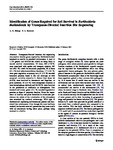Identification of genes required for soil survival in Burkholderia thailandensis by transposon-directed insertion site sequencing.
| dc.contributor.author | Bishop, AH | en |
| dc.contributor.author | Rachwal, PA | en |
| dc.date.accessioned | 2017-11-17T17:17:18Z | |
| dc.date.available | 2017-11-17T17:17:18Z | |
| dc.date.issued | 2014-06 | en |
| dc.identifier.uri | http://hdl.handle.net/10026.1/10206 | |
| dc.description.abstract |
Transposon-directed insertion site sequencing was used to identify genes required by Burkholderia thailandensis to survive in plant/soil microcosms. A total of 1,153 genetic loci fulfilled the criteria as being likely to encode survival characteristics. Of these, 203 (17.6 %) were associated with uptake and transport systems; 463 loci (40.1 %) coded for enzymatic properties, 99 of these (21.4 %) had reduction/oxidation functions; 117 (10.1 %) were gene regulation or sensory loci; 61 (5.3 %) encoded structural proteins found in the cell envelope or with enzymatic activities related to it, distinct from these, 46 (4.0 %) were involved in chemotaxis and flagellum, or pilus synthesis; 39 (3.4 %) were transposase enzymes or were bacteriophage-derived; and 30 (2.6 %) were involved in the production of antibiotics or siderophores. Two hundred and twenty genes (19.1 %) encoded hypothetical proteins or those of unknown function. Given the importance of motility and pilus formation in microcosm persistence the nature of the colonization of the rhizosphere was examined by confocal microscopy. Wild type B. thailandensis expressing red fluorescent protein was inoculated into microcosms. Even though the roots had been washed, the bacteria were still present but they were motile with no attachment having taken place, perhaps being retained in a biofilm. | en |
| dc.format.extent | 693 - 701 | en |
| dc.language | eng | en |
| dc.language.iso | eng | en |
| dc.subject | Burkholderia | en |
| dc.subject | DNA Transposable Elements | en |
| dc.subject | Genes, Bacterial | en |
| dc.subject | Microbial Viability | en |
| dc.subject | Mutagenesis, Insertional | en |
| dc.subject | Sequence Analysis, DNA | en |
| dc.subject | Soil Microbiology | en |
| dc.title | Identification of genes required for soil survival in Burkholderia thailandensis by transposon-directed insertion site sequencing. | en |
| dc.type | Journal Article | |
| plymouth.author-url | https://www.ncbi.nlm.nih.gov/pubmed/24488501 | en |
| plymouth.issue | 6 | en |
| plymouth.volume | 68 | en |
| plymouth.publication-status | Published | en |
| plymouth.journal | Curr Microbiol | en |
| dc.identifier.doi | 10.1007/s00284-014-0526-7 | en |
| plymouth.organisational-group | /Plymouth | |
| plymouth.organisational-group | /Plymouth/Faculty of Science and Engineering | |
| plymouth.organisational-group | /Plymouth/REF 2021 Researchers by UoA | |
| plymouth.organisational-group | /Plymouth/REF 2021 Researchers by UoA/UoA06 Agriculture, Veterinary and Food Science | |
| dc.publisher.place | United States | en |
| dcterms.dateAccepted | 2013-11-23 | en |
| dc.identifier.eissn | 1432-0991 | en |
| dc.rights.embargoperiod | Not known | en |
| rioxxterms.versionofrecord | 10.1007/s00284-014-0526-7 | en |
| rioxxterms.licenseref.uri | http://www.rioxx.net/licenses/all-rights-reserved | en |
| rioxxterms.licenseref.startdate | 2014-06 | en |
| rioxxterms.type | Journal Article/Review | en |


